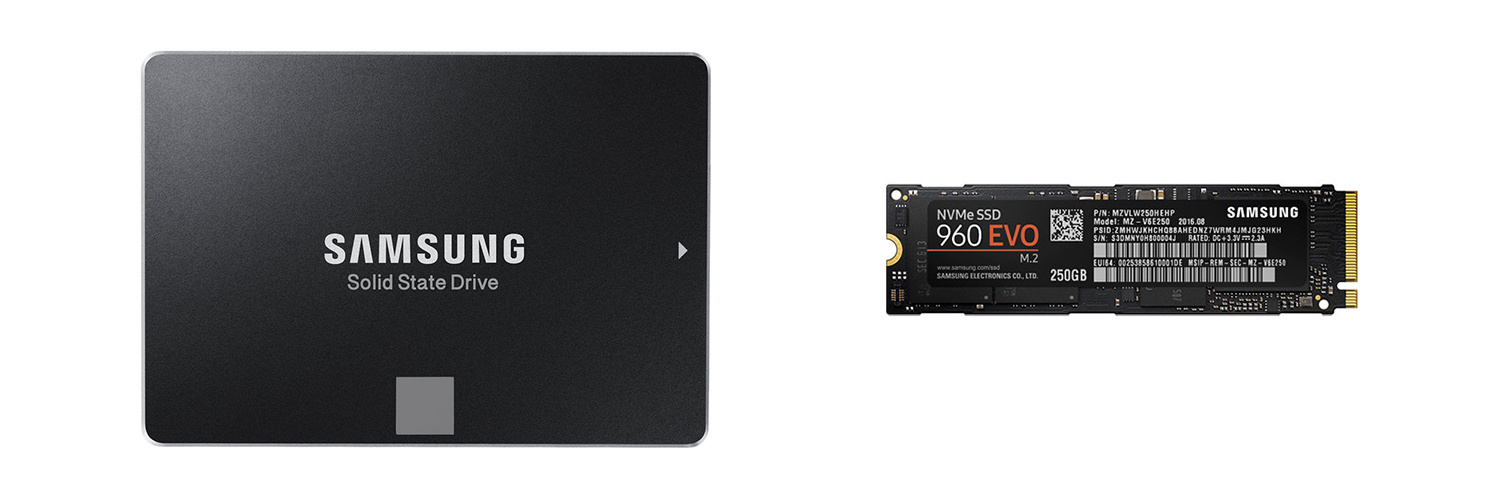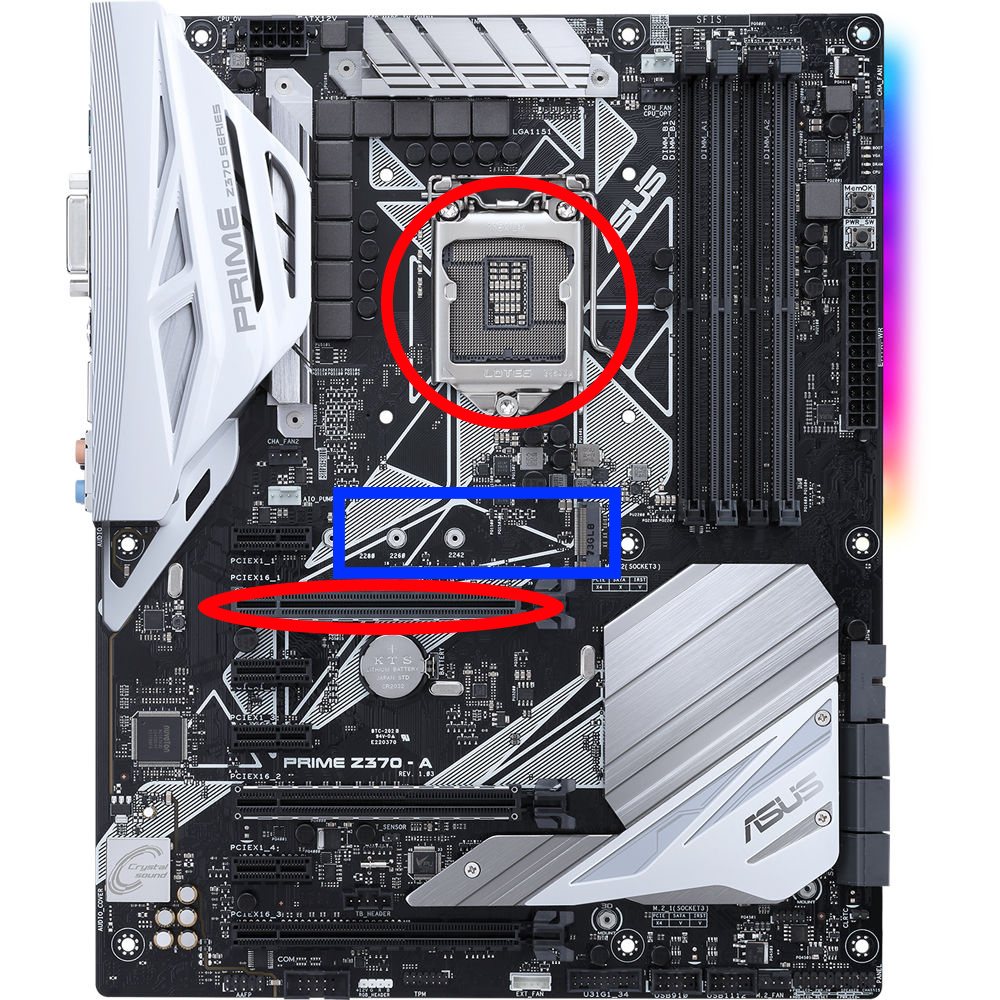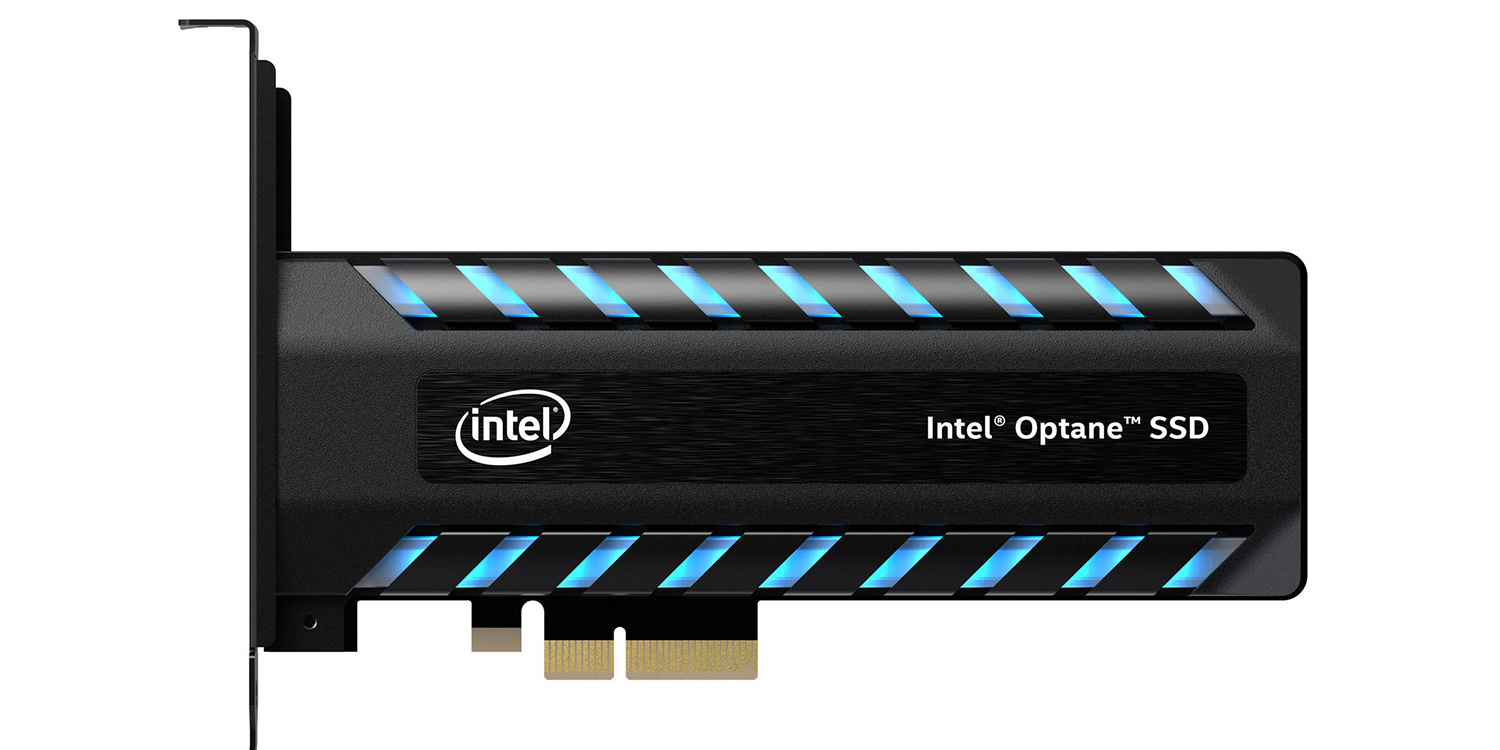What are the differences between a traditional SSD and a NVMe drive? Should I upgrade to NVMe? Which model should I pick? What are the main specifications? What about the new Intel Optane? Here is a detailed explanation to understand the advantages, weaknesses, and differences of these storage technologies.
SSD and NVMe Interface
A modern computer must have at least one SSD to run the main operating system (e.g. Windows 10, macOS). The speed and latency gain of the SSDs over traditional spinning hard drives is enormous. If possible, buy another SSD to dump the “hot” files that are being used on live editing projects. However, the current SATA interface is now reaching its limit (550MB/s) and the next generation of SSD based on the NVMe interface and PCIe bus is going to replace SATA in the future. That’s the main difference: an NVMe drive is just an SSD with a different shape (M.2), bus (PCIe), and interface (NVMe) while the regular SSD is just a SATA SSD with an “old” interface (SATA) and shape (2.5”). So instead of saying SSD versus NVMe, we should say SATA SSD and NVMe SSD. Here is an explanation about this standard:
Performance and price: Thanks to the new interface and PCIe bus, the NVMe SSD drives are up to six times faster than the typical SATA SSD. The latency and queuing operations are also vastly improved. However, these new SSDs are about 50 to 100% more expensive than the classic 2.5” SATA SSD.
NVMe interface: When the SSD became affordable for the consumer market around 2010, they inherited from the old SATA/AHCI interface initially designed for the traditional spinning hard drive architecture. At the time, this interface allowed an easy transition thanks to its compatibility with the SATA SSD but it also created a data bottleneck because of its limited bandwidth (550MB/s). To overcome the SATA limit, manufacturers created a new standard called NVMe in 2009 that progressively replaced the ACHI interface on the PCIe SSD. In real life, the NVMe technology offers great speed gain by reducing the latency and increasing the bandwidth.
PCIe bus: In order to handle the greater speed offered by the NVMe interface, the SSD must use the PCIe bus. NVMe drive are actually PCIe SSD. Therefore, some can be mounted directly on the PCIe slot like a graphic card but in general, the NVME SSD are attached via the M.2 connector because of the limited amount of PCIe slots (and the graphic card already uses the fastest line directly connected to the CPU).
M.2 form factor and connector: The classic SATA SSD uses the 2.5” form factor because it was the standard size for laptops hard drives. However, the 2.5” format is oversized for SSDs and they should be much smaller. The new NVMe SSD are getting rid of the 2.5” constraint to adopt the M.2 form factor also borrowed from the laptop industry. The M.2 NVMe SSD are not bigger than a gum stick. The number next to the NVMe SSD indicates the width and length of the drive in millimeters. For instance, 2280 SSD means 22mm (width) by 80mm (length). Many motherboards accept several sizes but the standard for desktop computers is becoming the 2280. But be careful: all M.2 shaped drives are not necessarily NVMe ready and the early M.2 versions were just using the old SATA interface. Finally, several types of socket are present on the M.2 drives (B key, M key and B+M key). However, the majority of the NVMe drives use the fastest M Key socket running at full speed over four PCIe lanes (versus two lanes for the B Key and B+M key).
Final word: Are you confused already? Don’t worry, the vast majority of NVMe drives are now following the same specifications: M.2 connector, 2280 size, and fast M Key socket (PCIe 4x). That’s all you need to check before buying a NMVe SSD.

SATA SSD versus M.2 NVMe SSD. Most NVMe drives like this one are based on the M.2 2280 form factor (22mm x 80mm) and come with a M Key socket (PCIe 4x).
Do You Really Need an NMVe SSD?
As we just saw, the classic 2.5” SATA SSD are limited by the SATA interface to 550 MB/s. On the other end, the best NVMe SSDs are currently reaching up to 3,500 MB/s (read) and 2,100 MB/s (write) speed, and they offer much better latency. They also cost twice as much compared to the SATA SSD. As always, the final answer depends on your budget and usage. In any case, NVMe SSD will seriously speed up your applications’ boot time and task-responsiveness, especially when working with large files. High-bandwidth materials like panoramic stitching and raw video will benefit from the additional bandwidth for preview and scrubbing. However, export performance won’t be as dramatic because the drive is rarely the limiting factor in this phase. Rendering is usually not limited by the drive but by the processing power of the CPU and GPU. Feeding more data to these processors won’t help when they already run at full capacity.
Eventually, a reasonable price/performance solution is to install an NVMe SSD for the operating system and add a cheaper SATA SSD to store the hot files like the images and video used on current editing projects. To give you an idea, most 12 bits intermediate Codec and even some lossy raw footage up to 4K resolution don’t saturate the SATA SSD bandwidth (Canon Cinema Raw Light is 1 Gbps, ProRes 4444XQ is 2.1 Gbps, Redcode 6:1 is 500 Mbps).
Another reason to wait before transitioning to the NVMe drive is the heating issue. Due to the architecture of desktop computer, NVMe drives are connected in PCIe next to the graphic card, one of the hottest part of the machine whereas SATA SSDs can be mounted away from the core of the computer thanks to the long SATA cable. Under heavy load and thermal stress, the performance of the NVMe drive can drop dramatically. If possible try to mount the NVMe as far as possible of the graphic card in a well-ventilated area (e.g. not directly above the GPU or next to the exhaust fan) and add a small fan to push cool air on the NVMe SSD. Verify the design of a desired motherboard before checking out in order to avoid an unpleasant surprise.

M.2 NVMe drives are sensitive to heat and their performance can drop significantly under heavy load when subject to thermal stress. Unfortunately, on many motherboards the M.2 slots (blue) are usually located next to the very hot GPU (red down) and CPU (red up).
What About the Intel Optane?
The Intel Optane drive is also based on the NVMe interface and PCIe bus but uses the new 3D XPoint flash memory developed by Intel for ultimate performance.

Optane SSD offers extreme performance and fast latency but they are expensive. Most Optane drive currently need to be mounted on a PCI slot.
This technology just hit the market last year and the latency speed is superlative but Optane drives are extremely expensive and only available in limited size (960GB at $1,300). For regular photo-video usage, the benefits of the Optane over the NVMe doesn’t justify the massive price difference (up to 4 to 6 times pricier). In addition, Intel proposes small Optane M.2 modules that can be used as cache memory to boost the performances of traditional hard drives. Except for large file transfer, the results are actually surprisingly good.
Conclusion: Can You Justify the Price Difference?
For common photo-video usage, classic SATA SSDs are more than enough to fulfill our needs as the actual SATA bandwith (550MB/s) and latency are still capable of handling most tasks reasonably well. If budget permits, a NVMe drive can be justified as the main computer drive to run the operating system and software. However, do you really need to spend twice the money for a NVMe SSD when this cash could be spent on a better CPU or GPU? The price difference between a 1TB SATA SSD ($164) and NVMe SSD ($300) is $136. This money represents the gap between a 6 cores and 8 cores processor. Sure, a NVMe drive will speed up the boot time and file transfer but these tasks are not necessarily critical. Should you save 50% of 20 seconds boot time or 10% of 30 minutes rendering?
As for the Optane drives, they are simply too expensive at the moment and the performance gain over a good NVMe drive is not correlated with the 400% price difference.







if money is not an issue, get it. just like buying other premium items instead of midrange/enthusiast level. youre paying a much higher price for the top end.
I personally wouldnt. I have no complaints from my regular 2.5" drive performance wise.
An Amendment to m.2, if you've got an B+M key m.2 stick then it's likely to be SATA based. I use these extensively for creating external storage drives and their main advantage is they are cheaper to buy. To confuse matters, m.2 is also very dependant on how much bandwidth is available as many motherboards only assign a Socket 2 configuration (2 lane / 2x PCI bandwidth) and many newer NVMe drives are Socket 3 ( x4). There is also two PCIe SSD protocols; AHCI and NVMe and depending on BIOS/drive firmware the latter may not be bootable in older systems. I use an PCIe x16 adaptor card to boot from NVMe m.2 drives on a Z820 that's NVMe but has boot protocols on the drive.
The M.2 socket can also handle WiFi and other devices (Mini PCIe) so it's not just restricted to drives but that's the most common configuration at present. So like the USB-C using the m.2 socket can be confusing as hell, more so because not all drives are the same.
Thanks for the explanation, that is something I knew nothing about before reading this article.
My HP Omen Ryzen PC is fitted with NVMe and SATA SSD's. I replaced the 1 TB hard disk with a Samsung 960 EVO 512 GB SSD and haven't had a single issue with overheating and this is without using a heatsink. I use SATA SSD's for the Windows pagefile and caches for Photo Mechanic, Camera Raw and Photoshop scratch disk. In my PCIe x4 slot is an Anglebird Wings NVMe M.2 card holding a Samsung 970 EVO 1 TB SSD which I use as my work area for images. I still have the Crucial SATA 512 GB SSD installed. While I haven't benchmarked my machine, I cannot complain about the performance.
I had few years old OCZ SSD as my windows boot drive (C:) and now I bought Samsung NVMe and I can feel the diffrence. Photoshop works faster and everything is a bit more instant.
I think your point about thermal issues with the m2 card being near the graphics card is very fishy... the slowdown is far more likely from limited pci express lanes limits... cpu's have limits on how many devices they can talk to at the same time, the cheaper the cpu the less lanes they have. Most GPU's use 16 lanes added to the 4 lanes for SSD and one for the wifi and maybe one for the wired lan, lane sharing happens and it slows down the system... this is very common with mobile processors with often have only 8~12 lanes.. When the gpu is being hit hard all the 16 channels will be in use forcing lane sharing, slowing down access to the storage. Sata goes via the chipset and DMI and is slower and has higher latency.
Just to support what you said: I upgraded from SSDs (around 500 MB/s) to nvme m.2 (2200+ MB/s) and saw ZERO performance difference for photo and 4k/60 video editing. We're all bottlenecking on the processor and Moore's law is long dead, so there is no hope of making your computer faster.
I know you like data and this article is a few years old but according to their tests there is a performance increase.
https://www.pugetsystems.com/labs/articles/Adobe-Premiere-Pro-CC-2015-4-...
Looked at my workload before building out my machine a couple of years ago and decided to use an Intel NVMe card for the Os and applications and just put my photos on RAID 1 multiterabyte spinning disk. For editing Nikon D850 files I just open a good number of photos at once and let them sit in RAM since it is much faster than any drive anyway. I tried doing some edits on the NVMe and other than opening the files or browsing through the photos there was no perceived difference. I would rather have everything important live on the RAID array.
After almost a year on NVMe with Samsung 960 EVO except boot up time, I can say that everything loads up pretty fast!
If your files are on the NVMe Drive the loading is Fast! Also the same with rendering, with simple Sata drive if you work with big files, lets say 4GB per file or more, the read of the file is just a glimpse of an eye. So overall all it's not just a few seconds on Rendering is more on that... but you need space to put the files of the Project on NV Drive.
The heating issue with the M.2 being close to the graphics card shouldn't be an issue at all. If you are getting slow down because of excessive heat, than you are causing harm to your system overall and are shortening the lifespan of the computer's components.
Most pre-built systems should have enough air flow to have this be a non-issue. Most Gaming and Rendering systems will have even better air flow or even liquid cooling. Those systems are also usually easier to upgrade/add new components without adding strain to your system.